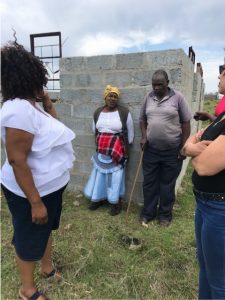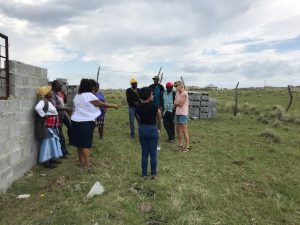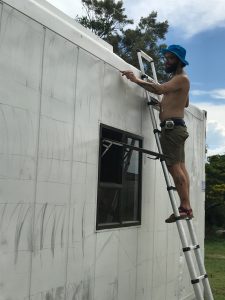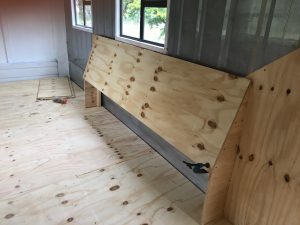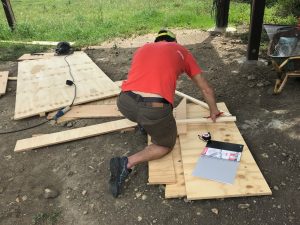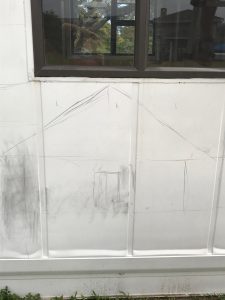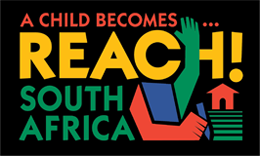December/January, 2019
Eastern Cape, South Africa
I spent a good part of December and into the new year in South Africa helping to implement our dream of opening a preschool. I kept a journal of our adventure and would like to share part of that story with you.
With the help of many generous donors, our Reach for South Africa project begins! We arrive as planned in Gonubie on the Eastern Cape. The container is delivered and the door and windows are installed. Thanks to our contact in Durban, we arrange a great price for the container included with a fresh coat of primer on the exterior.
People keep their word in this country with a promise and a handshake, however, we still have much work to do. It’s over 90 degrees outside. We are tired and jet-lagged. A simple reminder to us all, “take 3 mindful breaths. One day at a time.”
The Inside
First stop is the hardware store for plywood, screws, primer, paint, and paintbrushes. Ralph begins work on the inside and attaches plywood to the floor and walls.
Next up, the vinyl flooring. Unfortunately, the cost of the glue and tile is more than expected. We have decided to do half with tile and the other half with a carpet remnant. This will make a comfortable gathering spot for “group time.”
Enya our daughter, whom we call “Nunu”, works diligently painting the interior with primary colors and enjoys creating a colorful child friendly space. She uses acrylic paint and plans to paint the plywood black where the tile will not be placed. I am surprised at the amount of space, actually. 8 feet by 40 feet will provide for a perfect classroom..
Ralph installs very basic shelves for toys and supplies, and a long table for crafts – unpainted and sturdy. I have purchased several plastic containers for manipulatives and craft supplies. I have to think twice about paint as water is scarce in this region making clean up more challenging. Enya and I shop locally for toys and educational games.
There will be several “centers” in the classroom arranged with the teacher once the container is on site. The teacher is trained in East London by ITEC, the nonprofit who will directly support the needs of the classroom.
It is exhausting working on this container in the heat, especially when working inside. Fortunately, there is a tree with shade nearby for a rest and drink. Enya and Cleo the rescue dog find rest under a fever tree.
The Outside
We have brought along our son Sean, a professional artist and graphic designer. He agrees to donate two weeks of his time to create a mural on all 4 sides of the container. We are blessed and grateful to have not only his amazing talents, but his belief and support of our mission which is to provide education using our gifts of compassion, empathy, and physical strength.
We can’t wait to show our little students their new classroom. We hope the bright colors are an invitation to come running to school!
Watching Sean makes us appreciate and understand an artist at work. The mural comes in many stages beginning with pencil sketches. Then six colors are added, one at a time.
He sketches first in pencil.
The first splash of color is yellow. We look forward to the end of each day when a new animal or design takes shape. It is truly an exciting experience watching Sean’s mural develop.
Painting is a layering process. First red and green, and then followed by blue.
1-2-3-4-5-6 colors. The animals have all come alive! Elephant. Kudu. Rhino. Snake.
Transport to the Village
We made plans to head to the village for the big day. We woke early and departed at 5 AM aiming to meet our transport driver in a town three hours away. Unfortunately, the truck engine overheated and he couldn’t reach us. We waited in the heat in one of the poorest towns in the region for hours.
He scoured his sources for a truck that could make the drive, able to tow the newly built container classroom. After a trying two different vehicles, he finally found one that could make the trek. The container was loaded as we readied for travel.
The next day, we set off at 5 AM again. Our driver left at 4 AM. He wanted to beat us there. It would be a journey. To give you an idea of how rough the roads are for the truck, it took 2 1/2 hours to travel 30 kilometers.
Mission accomplished. We made it to the village!
One of the biggest surprises was the scene upon arrival to the village. The gathering of all the families; young and old, in dance and song, celebrating their new school. Xhosa villagers from all over: hillsides, out of huts, from the bushes. Children were running to us, most without shoes and a few without pants!
The Rainwater Collection System
Water conservation is a way of life in South Africa. The climate is relatively dry in comparison to the rest of the world and the region is experiencing an unprecedented drought. Harvesting rainwater is a common necessity for South Africans. You will see almost every home in South Africa, rural or city, with a JoJo tank attached outside. Water collected and stored in the tank is used as drinking water and for other household needs. This commonly used large green container holds 2500 liters of water.
Ralph and a few volunteers from the village, build the rainwater “catchment roof” onsite for the school’s JoJo tank which sits behind the container. This too had to be transported to the village on a trailer. The sloped roof catches the water, water goes into a gutter, down a spout and into the tank.
Some funny news on the radio over the weekend warned drivers: “There is a runaway JoJo tank rolling down the freeway. Take alternate routes!” Glad it wasn’t ours.
This pilot project touched my heart in ways I am still processing. We enabled education for 40 children in a rural village in South Africa. It all seemed so simple once we were done. Anyone can do this, actually. A preschool brought to a village, on a truck, with a teacher. Three weeks of work. Job complete.
A Christmas gift from A Child Becomes.
So ends our first South African service project. Reach for South Africa is a huge success because of you, our school family, who supports our mission of spreading compassion and empathy beyond our classroom walls.
To all of the donors who helped us raise over $15,000, we could not have done it without you.
Looking to the future? There are seven more schools needed in the region. We would love to open one each year. Any volunteers? Let’s keep the momentum.
December 20, 2018
School site, Eastern Cape, South Africa
Yesterday we traveled about three hours from Gonubie to the school site with an interpreter and Carol, the director of ITEC, the non-profit with whom we are partnered.
We discovered that the container will exceed the boundary line of the land allocated to us, and that the land would need to be leveled. What happened next was an amazing amalgamation of culture and tradition – the process of decision making! A messenger was dispatched to the village elders, who were summoned to our site. Slowly, they appeared over the hillside, one or two walking together with their traditional walking sticks in hand. Everyone must contribute to the decision making process, as the deliberations are inclusive and balanced. Nearly two hours later, consensus was reached. The boundaries could be extended four feet and the ground could be leveled to suit the new classroom container. Whew! This is ‘Africa time’, a frustrating pace for many westerners, but an imperative in this culture. Frankly, we could all benefit from a little more ‘Africa time’. They agreed to provide the labor required to level the area and to prepare the way for the truck hauling the container, soon to be their new school.
After decisions were made, we found ourselves overwhelmed by the showering of gratitude for the work being done; opportunity and education for their children and grandchildren. These are very content people, living simple, humble lives; it is refreshing and gratifying to be among them.
We then visited the site of our second school nearby and met the headman, whose wife is the teacher. We will keep you updated, and continue to send our sincere thanks for your help in making this all happen.
December 18, 2018
Gonubie, South Africa
Shelley has arrived in South Africa! Construction continues on the container in Gonubie and the interior is beginning to take shape. As well, Sean is sketching out the design that will color the exterior.
December 12, 2018
Gonubie, South Africa
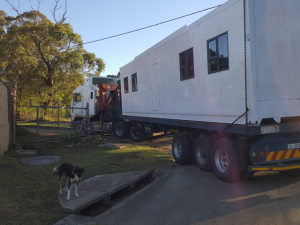 Ralph arrived in South Africa yesterday! He is now overseeing the work on our new container classroom which was just delivered to our work area in Gonubie. A contractor has installed windows and a door and it will spend two weeks here while we build out the interior – we’ll complete the finishes like walls, flooring, shelving, essentially the infrastructure of the classroom.
Ralph arrived in South Africa yesterday! He is now overseeing the work on our new container classroom which was just delivered to our work area in Gonubie. A contractor has installed windows and a door and it will spend two weeks here while we build out the interior – we’ll complete the finishes like walls, flooring, shelving, essentially the infrastructure of the classroom.
From here it will travel to it’s final destination in the village where we’ll add the play area, the eco-toilets, paint the exterior, and set up the classroom.
We’ll keep you posted as work progresses!
July 16, 2018
Eastern Cape
I am excited to share with you our first experiences in South Africa where we recently set in motion our Reach! For South Africa project, and began the process of building our sister school in one of the country’s poorest, yet most beautiful regions.
Our story…
It is July 16th, 2018. We have just arrived and we are a jet lagged. It is winter. Seventeen degrees Celsius. We wait outside the gates of our Air B n B where we are staying for the week. We anxiously wait for the arrival of the ITEC van, (The Non-Profit in SA with whom we are partnering) which will us to lead us to the village hours away from cozy East London in a remote area of the Eastern Cape, more precisely the Amajingqi district.
ITEC is based in East London, and does incredible work training early childhood teachers up to a Level 4, the equivalent of our assistant position, (or practitioners as they call them) and send them out into rural and impoverished areas in the Eastern Cape where 87% of the population is illiterate. It is following a long trail of networking that we were connected with ITEC. They have workers on the ground, a system in place, a fantastic attitude, do phenomenal work, and are thrilled to have us fill a much needed gap in a country where the Government has failed its people miserably.
ITEC operates on a combination of donations, partnering with local socially conscious companies, and running computer-training courses out of their offices. Whatever help they get from the government is irregular and insufficient. Through their work, they have built strong relationships with the Chief, and the community, and were happy to introduce us to both.
So begins our journey westward in tow behind this ITEC van…
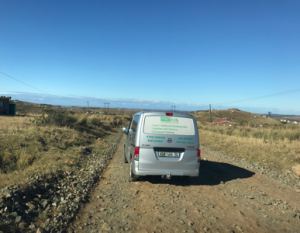 For three hours we drive thought rural Eastern Cape: rolling grass hills, scattered mud huts, goats, pigs, cows all wandering freely, small patches of withered corn (I remember its winter); the road is rocky and unmaintained, and local woman carry their supplies on their heads, the traditional way. I wonder how we will be received, these foreigners from halfway around the world bringing their lofty dreams? Will we be greeted with sincerity or suspicion?
For three hours we drive thought rural Eastern Cape: rolling grass hills, scattered mud huts, goats, pigs, cows all wandering freely, small patches of withered corn (I remember its winter); the road is rocky and unmaintained, and local woman carry their supplies on their heads, the traditional way. I wonder how we will be received, these foreigners from halfway around the world bringing their lofty dreams? Will we be greeted with sincerity or suspicion?
We reach the last town and stop before the Chief’s house. It is called Willowvale . Ironically, for me, a KFC is at the center of the town. KFC in rural South Africa? I can’t think of my least favorite food; greasy fried chicken. A petrol station and a few small shops with canned foods, cigarettes, milk, and eggs. The basics. Locals are on foot, dressed for winter.
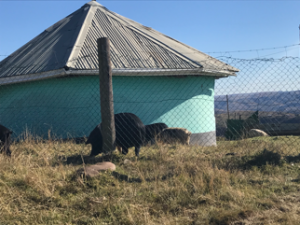 People are inquisitive. Some smile, some wave happily, some frown. There is a traffic jam in the middle of town where a tractor is blocking Main Street, currently under construction. We wait a ½ hour just to move 10 meters, but nobody seems to mind; this is Africa. I love it! Several young local girls ask to have their picture taken with our blond daughter… Instagram.
People are inquisitive. Some smile, some wave happily, some frown. There is a traffic jam in the middle of town where a tractor is blocking Main Street, currently under construction. We wait a ½ hour just to move 10 meters, but nobody seems to mind; this is Africa. I love it! Several young local girls ask to have their picture taken with our blond daughter… Instagram.
As we finally work our ways through traffic and leave the town of Willowvale, we are surprised to see a Builders hardware store, filled with lumber, tin roofing, concrete, bricks, fencing… all the basic building materials out here. It looks like they will have most of the supplies we will need for our small playground.
Thirty more minutes pass on bumpy roads and we see the Chiefs home. This is not a traditional hut, but something more western, brick and tile roof, with several outbuildings, and surrounded by a fence. We are greeted by three dogs and an elderly gentleman who speaks no English. We are invited into a building that appears designated for meetings. There are a dozen or so plastic chairs and 3 long tables. We see a platter of fried chicken and a kettle (KFC ring a bell?) We are offered a cup of tea or coffee and sit down to wait for the Chief.
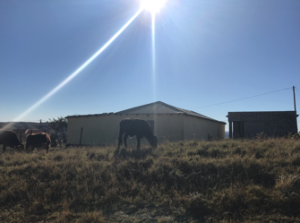 The Xhosa nation, long ago designated to this area by the apartheid regime, is made up of several tribes each headed by their own chief. Our project falls within the jurisdiction of the Amajingqi tribe and is led by Chief Sibongili Dumalisili, who we soon meet. He is a tall man with a broad smile, an easy laugh, and a natural authority that I admire at once. I am immediately put at ease. I offer to shake his hand but he hugs me instead. There are books he wishes to read but cannot find them locally, so I offer to send them to him.
The Xhosa nation, long ago designated to this area by the apartheid regime, is made up of several tribes each headed by their own chief. Our project falls within the jurisdiction of the Amajingqi tribe and is led by Chief Sibongili Dumalisili, who we soon meet. He is a tall man with a broad smile, an easy laugh, and a natural authority that I admire at once. I am immediately put at ease. I offer to shake his hand but he hugs me instead. There are books he wishes to read but cannot find them locally, so I offer to send them to him.
We start with a prayer in Xhosa.
The chief offers us refreshments, and then begins to lay out his 30 year plan. He is educated, well travelled, and ambitious. He speaks to the future of South Africa. He speaks of upcoming meetings with the new South African president. He is excited to hear our plan. Ralph, who speaks Zulu, similar to Xhosa, impresses him with a small introduction to his upbringing. We speak about compassion, about kindness He talks about his goal of realizing, through education, the human capital in the children. He speaks our language, metaphorically of course! He is thrilled, and invites us to be apart of his thirty-year plan. He must leave for a meeting in town, but wishes us well. He has authorized a designated area for our school, and waves us on our way.
After another half hour on bumpy, rocky roads we arrive at the location of our new school. It sits on top of a high headland and looks out over the blue Indian Ocean. It is a stunning setting.
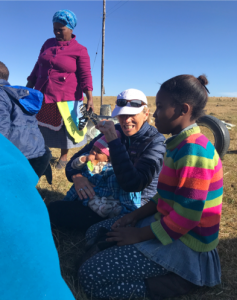 We are greeted by 22 children aged 2-5 and their teachers, who have assembled just for us. They run to the vans, waving, laughing. I want to jump out and give hugs to each of them. I cannot begin to describe the joy I could see in each child’s expression. We hand out fruit leather strips. We give them the donated shoes, and they begin to dance. One 12 year old is holding a baby. I ask her if I can hold her with hand and face gestures, and she hands the baby to me. They touch my clothes, my hair, they hold my hand, they look at me with wide trusting eyes, and I wish I could speak their language. Trust me, I want to say, I’m here to help, to try and make your future just a little better; I want to see you grow up with the opportunities you deserve. My heart is overflowing. We are led to their classroom, a mud hut that they have to vacate every weekend because it is only borrowed during the week. The teacher tells a story; I’ve heard Africans are exceptional storytellers, and I find it to be true. She speaks with expression, and passion, acting out animals, making their sounds. The children, all between 2 and 5, sit perfectly still, listening. The storyteller, a few winter sniffles, and the fly buzzing were the only sounds in the room.
We are greeted by 22 children aged 2-5 and their teachers, who have assembled just for us. They run to the vans, waving, laughing. I want to jump out and give hugs to each of them. I cannot begin to describe the joy I could see in each child’s expression. We hand out fruit leather strips. We give them the donated shoes, and they begin to dance. One 12 year old is holding a baby. I ask her if I can hold her with hand and face gestures, and she hands the baby to me. They touch my clothes, my hair, they hold my hand, they look at me with wide trusting eyes, and I wish I could speak their language. Trust me, I want to say, I’m here to help, to try and make your future just a little better; I want to see you grow up with the opportunities you deserve. My heart is overflowing. We are led to their classroom, a mud hut that they have to vacate every weekend because it is only borrowed during the week. The teacher tells a story; I’ve heard Africans are exceptional storytellers, and I find it to be true. She speaks with expression, and passion, acting out animals, making their sounds. The children, all between 2 and 5, sit perfectly still, listening. The storyteller, a few winter sniffles, and the fly buzzing were the only sounds in the room.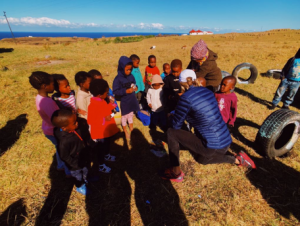
The materials on the walls that ITEC has provided consist of a few posters in Xhosa: alphabet and numbers. A few blocks, mats to sit on and some color crayons. There is so much we can do, I can barely contain myself, I want to start there and then.
I found that the young Xhosa children had many things in common with us. High 5’s and cartwheels and strong family bonds and friendships as well as a willingness to treat us as guest on their land and in their huts. Mothers held their babies tightly tied to their backs. Never once did I hear a cry from an infant.
My eyes wander a bit so I can take a picture in my head of all of the supplies in the makeshift classroom. I think I count maybe 10 total items to play with. These young children had to learn to share. It was survival of the classroom. There simply isn’t enough for everyone. I believe this is part of the experience that enables these children to have such patience and self-control. Children learned to share and take turns early on. Children gained early on many of the skills we teach daily.
It’s time to go, it is a long way back. We tell the children through a translator what we are going to be doing. We will be back, with a new school, new supplies, a toilet, a water tank for vegetables, a playground! It appears to be too much for them to comprehend, or perhaps they’ve been promised too many things in the past. The teachers are thrilled, they hug and thank us. We promise to see them in December. It feels so far away, there is so much we want to do for them, it is hard to leave. I promise not to forget a ring for my new teen friend.
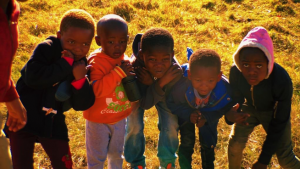 Children wave goodbye. They still have that content look about them knowing this is their home. But I could also see, in my own mysterious way, hope and anticipation. I knew I couldn’t let these kids down. We said we would be back. We will.
Children wave goodbye. They still have that content look about them knowing this is their home. But I could also see, in my own mysterious way, hope and anticipation. I knew I couldn’t let these kids down. We said we would be back. We will.
So begins our drive homeward. The experience from door to door was a total of 12 hours. The experiences will be held in my heart for a lifetime. I am grateful that my daughter could experience this. I am grateful that my husband is so eager to get started building our school. A sister school for A Child Becomes…has become a reality. In a way it will be like adopting a new sibling. There will be ups and downs. There will be challenges along the way.
But through our involvement we will be transformed. We will practice patience, compassion, and generosity. We know the importance of these virtues and want each of our children to have real opportunities. Even if the sharing takes place 10,000 miles away, it will be so much fun and so rewarding.
The child with a lot less than us in South Africa sure has a lot more than I thought. Ocean view, loving parents and now, an extended family.
From A Child Becomes to Reach for South Africa!
From one ocean view to another.
Let our work begin, one village at a time.
To be continued…..

